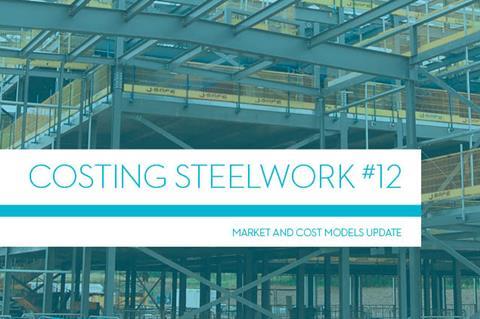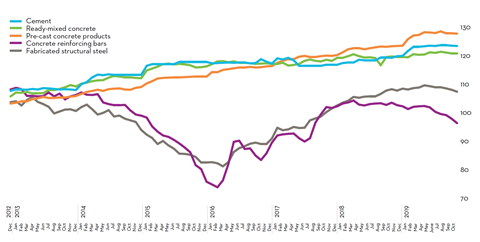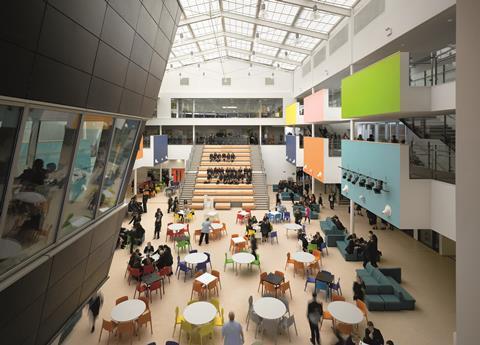Costing Steelwork is a series from Aecom, BCSA and Steel for Life that provides guidance on costing structural steelwork. This quarter provides a market update and updates the five cost models previously featured in Costing Steelwork.

Click here to read the full costing report.
UK business sentiment indicators act as a clear reflection of the economic and political uncertainties generated throughout 2019. Business surveys almost universally report dented confidence, with uncertainty increasing towards the end of the year as a UK general election was held. The CBI reports on-going weakness in investment plans and weak prospects for exports. A resolution to the UK’s exit from the EU is hoped to lift some of the fog.
A flat GDP run-rate indicates a lukewarm assessment of the UK’s economy. Brexit is the overwhelming issue mentioned as the reason for sluggishness. A stockpiling push in early Q3 2019 helped trading and economic activity across the UK but this was not to the same extent as that which took place in Q1 2019 ahead of the first Brexit deadline. Despite everything, UK GDP has shown resilience. Without doubt, Brexit is a handbrake to economic and construction activity.
New orders recorded little movement in Q3, posting 0.3% growth quarter‑on‑quarter
Headline construction new work output posted a modicum of growth in Q2, followed by a reversal and slight contraction in Q3. Current headline output levels equate with an industry near a long-run average output level. The key question is the direction of the output trend now, particularly given the economic and political backdrop. Similarly, new orders recorded little movement in Q3, posting 0.3% growth quarter‑on‑quarter.
Sterling’s path is linked directly to the UK’s story of exiting the EU. Overwhelmingly, the rising and falling likelihood of “no deal” at various points through the year drove the larger movements. This dynamic will continue in 2020. Towards the end of 2019, a trade-weighted sterling index was still within the range plotted since 2016. But it has sat at the top of this band lately in response to some Brexit deal-related optimism. Sterling’s fluctuations will continue to influence the rate of cost change for building materials costs.
Direct cost impacts are regularly the focus of attention in Brexit-related discussions and commentary. Tariffs are often the headline consideration. But when Brexit occurs, and should there be any additional friction from non-tariff barriers at UK borders, then this factor will become a considerably larger issue in the management and delivery of construction projects where the materials and components are imported.
There will be on-going localised pricing spikes though
Aecom’s composite index for building costs – comprised of materials and labour inputs – rose by 3.5% over the year at Q3 2019. Further increases to the end of the year were expected by much of the supply chain, but some weakening of this view is evident now on the back of marginally slower yearly growth in materials costs. Existing workload, planning for next projects and challenges securing trade resources will keep some of the commercial pressures on for supply chain firms but with less intensity than in recent years. There will be on-going localised pricing spikes though, where UK regions are still experiencing high activity.
Supply chain capacity across the UK construction industry opened up through 2019. The movement is notable and changes can be expected in response to adjustments in overall sentiment, activity and output. Recruitment for non-site skills and disciplines softened too, but without going into outright reverse. A pause here is understandable and correlates directly with the broader period of slower economic activity across the UK economy.
Changes in capacity utilisation measures are leading to labour wage changes, with an aggregate measure of site labour wage rates increasing by just under 3% annually in Q3 2019. This is softer wage growth than that seen earlier in 2019, when it ranged between 4% and 6% year-on-year.
Tender prices increased by 2.8% over the year at Q3 2019. The principle drivers of price inflation remain in place but with softer underlying trends. Supply chain pricing, input costs (labour and materials) and some necessary risk allowances are all still in play as drivers of inflation. Notably, preliminaries are lower over 2019.
Aecom’s baseline forecasts for tender price inflation are 0.9% from Q4 2019 to Q4 2020, and then 1.8% from Q4 2020 to Q4 2021. Downside skew accompanying the forecasts is noticeably higher across the period. Assumptions underpinning the forecasts include output reverting to somewhere near a long-run average without excessive volatility; input costs higher than the general rate of consumer price inflation; and an orderly exit of the UK from the EU that generates some upside risks from a synchronised release of held projects.
Sourcing cost information
Cost information is generally derived from a variety of sources, including similar projects, market testing and benchmarking. Due to the mix of source information it is important to establish relevance, which is paramount when comparing buildings in size, form and complexity.
Figure 3 represents the costs associated with the structural framing of a building, with a BCIS location factor of 100 expressed as a cost/m² on GIFA. The range of costs represents variances in the key cost drivers. If a building’s frame cost sits outside these ranges, this should act as a prompt to interrogate the design and determine the contributing factors.
The location of a project is a key factor in price determination, and indices are available to enable the adjustment of cost data across different regions. The variances in these indices, such as the BCIS location factors (figure 4), highlight the existence of different market conditions in different regions.
Figure 1: Material price trends

Figure 2: Tender price inflation, Aecom Tender Price Index, 2015=100
| Forecast | |||||||
|---|---|---|---|---|---|---|---|
|
Quarter |
2016 |
2017 |
2018 |
2019 |
2020 |
2021 |
2022 |
|
1 |
105.8 |
110.9 |
113.2 |
117.9 |
119.3 |
120.6 |
123.0 |
|
2 |
107.7 |
111.3 |
113.6 |
118.2 |
119.5 |
121.1 |
123.7 |
|
3 |
108.7 |
112.2 |
115.4 |
118.6 |
119.8 |
121.6 |
124.6 |
|
4 |
109.9 |
112.6 |
117.3 |
119.0 |
120.1 |
122.2 |
125.1 |
Figure 3: Indicative cost ranges based on gross internal floor area
| TYPE | Base index 100 (£/m2) | Notes |
|---|---|---|
|
Frames |
||
|
Steel frame to low-rise building |
101-123 |
Steelwork design based on 55kg/m2 |
|
Steel frame to high-rise building |
170-192 |
Steelwork design based on 90kg/m2 |
|
Complex steel frame |
192-227 |
Steelwork design based on 110kg/m2 |
|
Floors |
||
|
Composite floors, metal decking and lightweight concrete topping |
61-95 |
Two-way spanning deck, typical 3m span with concrete topping up to 150mm |
|
Precast concrete composite floor with concrete topping |
101-143 |
Hollowcore precast concrete planks with structural concrete topping spanning between primary steel beams |
|
Fire protection |
||
|
Fire protection to steel columns and beams (60 minutes resistance) |
14-20 |
Factory applied intumescent coating |
|
Fire protection to steel columns and beams (90 minutes resistance) |
16-29 |
Factory applied intumescent coating |
|
Portal frames |
||
|
Large-span single-storey building with low eaves (6-8m) |
75-98 |
Steelwork design based on 35kg/m2 |
|
Large-span single-storey building with high eaves (10-13m) |
86-118 |
Steelwork design based on 45kg/m2 |
Figure 4: BCIS location factors, as at Q4 2019
| Location | BCIS Index | Location | BCIS Index |
|---|---|---|---|
|
Central London |
128 |
Nottingham |
104 |
|
Manchester |
100 |
Glasgow |
93 |
|
Birmingham |
95 |
Newcastle |
90 |
|
Liverpool |
95 |
Cardiff |
90 |
|
Leeds |
95 |
Dublin |
96* |
Steel For Life sponsors
Headline

Gold
Ficep UK Ltd, National Tube Stockholders and Cleveland Steel & Tubes, Peddinghaus Corporation, voestalpine Metsec plc, Wedge Group Galvanizing Ltd
Silver
Jack Tighe Ltd, Kaltenbach Ltd, Tata Steel, Trimble Solutions (UK) Ltd
Cost comparison updates
This quarter’s Costing Steelwork provides an update of the five previously featured cost comparisons covering: offices, education, industrial, retail and mixed-use
These five projects were originally part of the Target Zero study conducted by a consortium of organisations including Tata Steel, Aecom, SCI, Cyril Sweett and the BCSA in 2010 to provide guidance on the design and construction of sustainable, low- and zero-carbon buildings in the UK. The cost models for these five projects have been reviewed and updated as part of the Costing Steelwork series. The latest cost models as of Q4 2019 are presented here.
Costing steelwork: offices update
Below is an update to the offices cost comparison originally published in the Costing Steelwork Offices feature in �ڶ����� magazine in April 2017.
One Kingdom Street, London, key features
- 10 storeys, with two levels of basement
- Typical clear spans of 12m x 10.5m
- Three cores – one main core with open atrium, scenic atrium bridges and lifts
- Plant at roof level
Cost comparison
Two structural options for the office building were assessed (as shown in figure 5):
- Base case – a steel frame, comprising fabricated cellular steel beams supporting a lightweight concrete slab on a profiled steel deck
- Option 1 – 350mm-thick post-tensioned concrete flat slab with a 650mm x 1,050mm perimeter beam.
The full building cost plans for each structural option have been reviewed and updated to provide current costs at Q4 2019. Movement has continued to be relatively static from Q3 2019. The costs, which include preliminaries, overheads, profit and a contingency, are summarised in figure 5.
The cost of the steel composite solution is 7% lower than that for the post-tensioned concrete flat slab alternative for the frame and upper floors, and 5% lower on a total building basis.
Figure 5: Key costs £/m² (GIFA), for City of London office building
| Elements | Steel composite | Post-tensioned concrete flat slab |
|---|---|---|
|
Substructure |
89 |
94 |
|
Frame and upper floors |
440 |
474 |
|
Total building |
2,642 |
2,784 |

Costing steelwork: education update
Below is an update to the education cost comparison originally published in the Costing Steelwork Education feature in �ڶ����� magazine in July 2017.
Christ the King Centre for Learning, Merseyside, key features
- Three storeys, with no basement levels
- Typical clear spans of 9m x 9m
- 591m2 sports hall (with glulam frame), 770m2 activity area and atrium
- Plant at roof level
Cost comparison
Three structural options for the building were assessed (as shown in figure 6), which include:
- Base case – steel frame, 250mm hollowcore precast concrete planks with 75mm structural screed
- Option 1 – in situ 350mm reinforced concrete flat slab with 400mm x 400mm columns
- Option 2 – steel frame, 130mm concrete topping on structural metal deck.
The full building cost plans for each option have been updated to provide current costs at Q4 2019. The comparative costs highlight the importance of considering total building cost when selecting the structural frame material.
The concrete flat slab option has a marginally lower frame and floor cost compared with the steel composite option, but on a total-building basis, the steel composite option has a lower overall cost £3,143/m2 against £3,169/m2. This is because of lower substructure and roof costs, alongside lower preliminaries resulting from the shorter programme.
Figure 6: Key costs £/m² (GIFA), for Merseyside secondary school
| Elements | Steel + precast hollow-core planks | In situ concrete flat slab | Steel comp-osite |
|---|---|---|---|
|
Frame and upper floors |
293 |
253 |
266 |
|
Total building |
3,200 |
3,169 |
3,143 |
Costing steelwork: industrial update
Below is an update to the industrial cost comparison originally published in the Costing Steelwork Industrial feature in �ڶ����� magazine in October 2017.
Distribution warehouse in ProLogis Park, Stoke-on-Trent, key features
- Warehouse: four-span, steel portal frame, with a net internal floor area of 34,000m2
- Office: 1,400m2, two-storey office wing with a braced steel frame with columns
Cost comparison
Three frame options were considered:
- Base option – a steel portal frame with a simple roof solution
- Option 1 – a hybrid option: precast concrete column and glulam beams with timber rafters
- Option 2 – a steel portal frame with a northlight roof solution.
The full building cost plans for each option have been updated to provide costs at Q4 2019. The steel portal frame provides optimum build value at £688/m2; glulam is least cost-efficient. This is primarily due to the cost premium for the structural members necessary to provide the required spans, which are otherwise efficiently catered for in the steelwork solution.
With a hybrid, the elements are from different suppliers, which raises the cost. The northlights option is directly comparable with the portal frame in relation to the warehouse and office frame. The variance is in the roof framing as the northlights need more. Other additional costs relate to the glazing of the northlights.
Figure 7: Key costs £/m2 (GIFA), for Stoke-on-Trent distribution warehouse
| Elements | Steel portal frame | Glulam beams + purlins + concrete columns | Steel portal frame + north-lights |
|---|---|---|---|
|
Warehouse |
70 |
143 |
83 |
|
Office |
130 |
172 |
130 |
|
Total frame |
74 |
144 |
87 |
|
Total building |
688 |
770 |
739 |
Costing steelwork: retail update
Below is an update to the retail cost comparison originally published in the Costing Steelwork retail feature in �ڶ����� magazine in January 2018.
Asda food store, Stockton-on-Tees, key features
- Total floor area of 9,393m2
- Retail area based on 12m x 12m structural grid
Cost comparison
Three frame options were considered (as shown in figure 8) to establish the optimum solution for the building, as follows:
- Base option – a steel portal frame on CFA piles
- Option 1 – glulam timber rafters and columns on CFA piles
- Option 2 – a steel portal frame with a northlight roof solution on driven steel piles.
The full building cost plans for each option have been updated to provide costs at Q4 2019. The steel portal frame provides the optimum build value at £2,616/m2, with the glulam option the least cost-efficient. The greater cost is due to the direct comparison of the steel frame solution against the glulam columns and beams/ rafters. A significant proportion of the building cost is in the M&E services and fit-out elements, which reduce the impact of the structural changes.
The northlights option is directly comparable with the portal frame in relation to the main supermarket – the variance is in the roof framing as the northlights require more. Additional costs beyond the frame are related to the glazing of the northlights and the overall increase in relative roof area.
Figure 8: Key costs £/m2 (GIFA), for Stockton-on-Tees food store
| Elements | Steel portal frame | Glulam timber rafters + columns | Steel portal frame + north-lights |
|---|---|---|---|
|
Structural unit cost |
144 |
176 |
162 |
|
Total building unit cost |
2,616 |
2,656 |
2,626 |
Costing steelwork: mixed-use update
Below is an update to the mixed-use cost comparison originally published in the Costing Steelwork mixed-use focus feature in �ڶ����� magazine in April 2018.
Holiday Inn tower, MediaCityUK, Manchester
- 17-storey tower
- 7,153m2 of open-plan office space on five floors (floors two to six)
- 9,265m2 of hotel space on eight floors (floors eight to 15)
The gross internal floor area of the building is 18,625m2. The 67m-high building is rectilinear with approximate dimensions of 74m x 15.3m.
Cost comparison
Three frame options were considered to establish the optimum solution for the building:
- Base option – steel frame with Slimdek floors
- Option 1 – concrete flat slab
- Option 2 – composite deck on cellular beams (offices) and UCs used as beams (hotel).
The full building cost plans for each option have been updated to provide costs at Q4 2019. The steel frame with composite deck continues to provide the optimum build value, with the overall building cost at £2,587/m2.
Options 1 and 2 are arguably more typical for this building type. The base case structure is an unusual solution due to a decision to change the residential accommodation to office floors at a very late stage – time constraints precluded redesign of the tower block, hence the original Slimdek design was constructed.
Figure 9: Key costs £/m2 (GIFA), for hotel/office building in Manchester
| Elements | Steel frame with Slimdek | Concrete flat slab | Composite deck on cellular beams (offices) and UCs used as beams (hotel) |
|---|---|---|---|
|
Structural unit cost |
515 |
431 |
352 |
|
Total building unit cost |
2,795 |
2,692 |
2,587 |
This Costing Steelwork article produced by Patrick McNamara (director) and Michael Hubbard (associate) of Aecom is available at .
The data and rates contained in this article have been produced for comparative purposes only and should not be used or relied upon for any other purpose without further discussion with Aecom. Aecom does not owe a duty of care to the reader or accept responsibility for any reliance on the article contents.



























No comments yet